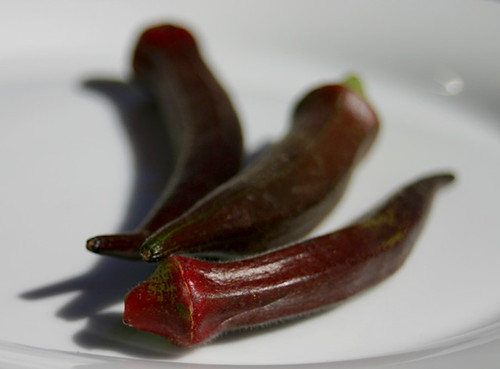I've always had a thing for sticky, gooey things as my love for natto and yamaimo attest, and I fell in love with okra the first time I had it. My aunt used to make this lovely dish composed of the Trinity of Stickiness - natto, yamaimo, and okra - all chopped up into small pieces for maximum stickiness, lightly seasoned with ponzu. It was as though she collected all my favorite things into one dish.

I recently found this red okra at the farmer's market in Pleasanton and jumped on it. I've been trying to explore new vegetables, and the red okra seemed to be an interesting twist on a old favorite. Unfortunately, my adventures are often not fruitful, as I found out from all my recent fruit tastings. These red okra had a harder-than-necessary outer skin that took away from the stickiness and the delicious sliminess. Blah.
Oh well, they made for a pretty picture...
PS:
OkAra is indeed a Japanese word, and it is tofu curd. It is produced similarly to cheese curd, except instead of milk, soy milk is used during the process of making tofu. Unlike okra, okara is dry and most often than not, blah.
PS2:
I'm secretly not very adventurous, am I?
PS3:
I'm going to try several new places this weekend, so I promise next week's posts will be slightly more exciting than my tinkerings in the kitchen!
2 comments:
I think it would be more accurate to describe okara as soybean mash, and is essentially the byproduct of making soymilk. Ground soybeans are simmered with water and then strained to get soymilk. The soymilk is then curdled with nigari to make the curds for tofu.
Okara is only dry if produced industrially, because they squeeze out the soymilk so efficiently; the okara I get when I make tofu or godoufu at home is pretty moist, and great for making okara-korokke. If I get some commercially made okara, I add a lot of dashi and maybe some mirin and so on to make it moist again. I sometimes use fresh okara in jiaozi or baozi fillings, too.
Hi, Jason,
Yeah, my ba-chan used to make okara all the time... I think my sister was was far more fond of the okara than I was as far as I remember... I was much more of that typical Japanese child, preferring curry rice and ramen over okara!
The Papa Bear used to make his own soy milk and he didn't know okara was edible! Too mealy, he says. He recently tried a variation our friend made, and he really liked it!
Post a Comment